Question Types on the AP U.S. History Exam
April 8, 2024

The AP U.S. History exam, also called the APUSH exam, tests your ability to use historical thinking skills and reasoning processes and your understanding of historical themes. There are several different question types on the AP U.S. History exam you should practice before taking the exam in May. The APUSH exam has two sections, and each section has two parts. Section I consists of multiple-choice and short-answer questions. Section II consists of the document-based question and long essay question. Familiarizing yourself with the question types on the exam will help you feel more confident on test day.
What are the Four Question Types on the AP U.S. History Exam?
There are four types of questions on the AP U.S. history exam. This includes 55 multiple-choice questions, three short-answer questions, one document-based question (DBQ), and one long essay question (LEQ). You will have 95 minutes for the first section, which includes the multiple-choice questions and short-answer questions, and 100 minutes for the essay section. It is important to pace yourself to have sufficient time to answer all the questions.
AP U.S. History Question Types: Multiple-Choice Questions
The first part of the APUSH exam includes 55 multiple-choice questions, which you must answer in 55 minutes. 40% of your total exam grade is based on this section.
The multiple-choice questions on the APUSH exam test your ability to reason about different types of historical evidence. You will be required to show proficiency in one or more of the themes and apply one or more of the historical thinking skills or processes. The multiple-choice questions require you to reason about specific stimulus material provided with each set of questions. The types of stimulus material can be anything from political cartoons to speeches – virtually any primary or secondary source. These questions will ask you to draw on the stimulus material as well as your knowledge of the concepts and historical developments in the College Board’s course framework.
Expert tip: Bring a watch when you take the APUSH exam and try to work at a steady pace. In the multiple-choice section, you only have a minute for each question. If the answer doesn’t immediately come to you, make a notation in the test booklet and come back to it.
[ LISTEN: Barron’s AP U.S. History Podcast Episode 9: “Multiple-Choice Questions” on Apple and Spotify ]
Sample Multiple-Choice Question
The following is an example of a multiple-choice question you would find on the AP U.S. History exam. In this case, you are presented with a political cartoon that you must use to answer the question below.
Question 1 refers to the following image:
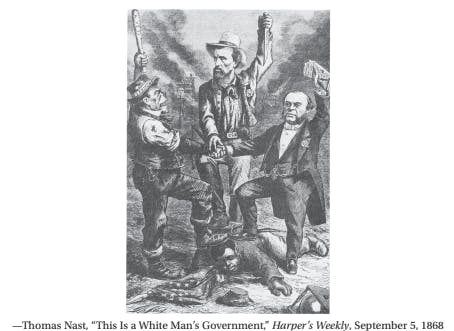
- The political cartoon shown above makes the point that
a. northern capitalists benefit as much from the institution of slavery as southern plantation owners do.
b. Reconstruction was brought to an unfortunate end by a coalition of forces in the North and South.
c. African Americans were incapable of effectively participating in the political process.
d. nativist politicians were unfairly presenting Irish Americans as ignorant and brutish.
Check your answer.
Answer: (B) This evocative political cartoon requires you to read a whole host of clues before you can understand its meaning. The man on the left is an Irish immigrant; the “5 Points” on his hat refers to the Irish neighborhood in New York City. Note his almost ape-like face. This was typical of representations of Irish immigrants as drawn by nativist cartoonists. The man in the middle has “C.S.A.” on his belt buckle: Confederate States of America. His knife says “Lost Cause,” an allusion to the southern nostalgia for the noble fight the South put up in the Civil War. The man on the right has “Capital” written on the object he is holding; he is a northern capitalist, ready to use money to purchase votes.
These three sinister forces are working together in the Democratic Party to deny African Americans the right to vote. Note the ballot box contents strewn on the ground in the lower right-hand corner of the cartoon. Thomas Nast intended the cartoon as a warning about the dangers of a Democratic victory in the upcoming presidential election. The cartoon does not allude to the slave system or cotton production (A). The cartoon is drawn sympathetically toward African Americans; there is no allusion that the man on the ground is ignorant or debased (C). It is true that Irish immigrants were presented as ignorant, but the cartoonist is not critiquing that. In fact, he himself is presenting an Irish immigrant in an unflattering manner (D).
AP U.S. History Question Types: Short-Answer Questions
Section I, Part B of the APUSH exam consists of four short-answer questions, of which you will answer three. The first two questions are required, then you will choose whether to respond to the third or fourth question. Each short-answer question has three parts, with each part given a grade of 0 or 1. The maximum grade for each short-answer question is a score of 3. You will have 40 minutes to complete the short-answer questions, and 20% of your total exam grade is based on this section.
- Short-answer question #1: The first short-answer question on the AP U.S. History exam will assess your ability to analyze secondary sources. You will be presented with one or two secondary sources – generally excerpts from the work of one or more historians. The question will ask you to describe a historical interpretation or to describe differences in historical interpretation. Then it will ask you to explain how evidence from the period under discussion could be used to support the interpretation(s). This first question will draw on material from Periods 3 to 8 (1754-1980).
- Short-answer question #2: The second short-answer question on the exam will include primary source material, such as newspaper articles. The question will use one of two reasoning practices – causation or comparison. You will be asked to describe the document’s significance and use historical evidence to explain a historical development related to the image. This question will also draw on material from Periods 3 to 8.
- Short-answer question #3: Last, you will be provided with a choice of two questions to answer for your third question on the APUSH exam. Neither of these questions will have stimulus material. They will both use the same reasoning skill—either causation or
comparison (whichever of the two skills that was not used in the second question). A causation question will ask you to describe a historical development and explain its causes and/or effects. A comparison question will present you with two historical developments and ask you to describe how they are similar and how they are different. In addition, it may ask you to explain the reasons for differences or the impact of one or the other historical development. Again, you will be asked to provide relevant historical evidence. The first of these two questions (Question 3) will draw from material in Periods 1 through 5 (1491-1877); the second of the two questions (Question 4) will draw from material in Periods 6 through 9 (1865-Present). Be sure to choose the short-answer question you feel most confident in answering.
[ LISTEN: Barron’s AP U.S. History Podcast Episode 10: “Short-Answer Questions” on Apple and Spotify ]
Sample Short-Answer Question
Below is one example of a short-answer question you might encounter on the AP U.S. history exam. In this example, you are required to use the excerpts below to answer the three-part question.
Question 1 refers to following excerpts:
“Out of this frontier democratic society where the freedom and abundance of land in the great
Valley opened a refuge to the oppressed in all regions, came the Jacksonian democracy. . . . It was because Andrew Jackson personified these essential Western traits that in his presidency he became the idol and mouthpiece of the popular will. . . . [H]e went directly to his object with the ruthless energy of a frontiersman. . . . The triumph of Andrew Jackson marked the end of the old era of trained statesmen for the Presidency. With him began the era of the popular hero.”
Frederick Jackson Turner, historian, The Frontier in American History, 1920
“Not only was [Andrew] Jackson not a consistent politician, he was not even a real leader of democracy. He had no part whatever in the promotion of the liberal movement which was progressing in his own state. . . . [H]e always believed in making the public serve the ends of the politician. Democracy was good talk with which to win the favor of the people and thereby accomplish ulterior objectives. Jackson never championed the cause of the people; he only
invited them to champion his.”
Thomas P. Abernathy, historian, From Frontier to Plantation in Tennessee, 1932
- Using the excerpts above, answer (a), (b), and (c).
a. Briefly describe ONE major difference between Turner’s and Abernathy’s historical interpretations of President Andrew Jackson.
b. Briefly explain how ONE specific historical event or development during the period 1820 to 1850 that is not explicitly mentioned in the excerpts could be used to support Turner’s interpretation.
c. Briefly explain how ONE specific historical event or development during the period 1820 to 1850 that is not explicitly mentioned in the excerpts could be used to support Abernathy’s interpretation.
Check your answer.
(a) A good response would explain differences between Turner’s and Abernathy’s historical interpretations of President Andrew Jackson, such as:
Both Turner and Abernathy address the issue of whether President Andrew Jackson was a “man of the people,” an upholder and proponent of democratic values. Turner argues that Jackson does live up to his reputation as a true democrat. He traces Jackson’s democratic spirit back to his upbringing in the frontier region, along the border of the colonies of North and South Carolina. Turner asserts that the region fostered an independent and egalitarian spirit that was reflected in Jackson’s actions. Abernathy, however, argues that Jackson’s talk of democracy was hollow. He asserts that Jackson was typical of most politicians in that he was self-serving. He talked about the interests of the common man, but his policies did not advance a democratic agenda.
(b) Good responses would cite evidence that would support Turner’s interpretation of Jackson, such as:
Jackson supported the rotation of office in government, also known as the “spoils system.” Jackson brought new individuals into government positions rather than allowing the old established officeholders to continue to exercise power.
(c) Good responses would cite evidence that would support Abernathy’s interpretation of Jackson, such as:
Jackson did not attempt to promote the right to vote for people other than white males. As a slaveholder, he did not want to extend democratic rights to African Americans or to challenge the institution of slavery. Nor did he support extending democratic rights to women.
AP U.S. History Question Types: Document-Based Question
The second section of the AP U.S. history exam begins after a short break. In Section II, Part A, you will answer a document-based question, or DBQ. You will have 60 minutes to complete this part of the exam, and it is worth 25% of your total exam grade.
The DBQ evaluates your ability to assess, analyze, and synthesize various types of historical evidence and construct a coherent essay. Your written response is judged on your ability to formulate a thesis and support it with relevant evidence. The documents can include written materials, charts, graphs, cartoons, and pictures. Each DBQ on the APUSH exam will focus on one of the historical reasoning processes: comparison, causation, or continuity. It will also assess all six historical thinking skills – skills—developments and processes, sourcing and situation, claims and evidence in sources, contextualization, making connections, and argumentation.
Expert tip: When writing your response to the document-based question, be sure to maintain historical neutrality. Avoid using words like “us” or “our” when discussing the United States. Strong essays should be intellectually engaged but not emotionally invested in a particular outcome or position. Such personal investment tends to undermine one’s argument.
[ LISTEN: Barron’s AP U.S. History Podcast Episode 11: “The Document-Based Question” on Apple and Spotify ]
Sample Document-Based Question
The following is an example of a document-based question. We suggest you spend 15 minutes reading the documents and 45 minutes writing your response. This sample DBQ is based on the documents below.
In your response, you should do the following:
- Respond to the prompt with a historically defensible thesis or claim that establishes a line of reasoning.
- Describe a broader historical context relevant to the prompt.
- Use at least six documents in order to support an argument in response to the prompt.
- Use at least one additional piece of specific historical evidence (beyond that found in the documents) relevant to an argument about the prompt.
- For at least three documents, explain how or why the document’s point of view, purpose, historical situation, and/or audience is relevant to an argument.
- Use evidence to corroborate, qualify, or modify an argument that addresses the prompt.
Prompt: Compare the mobilization efforts by local, state, and federal authorities in the United States during World War I with mobilization efforts during World War II.
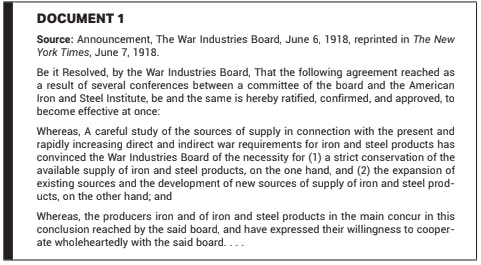
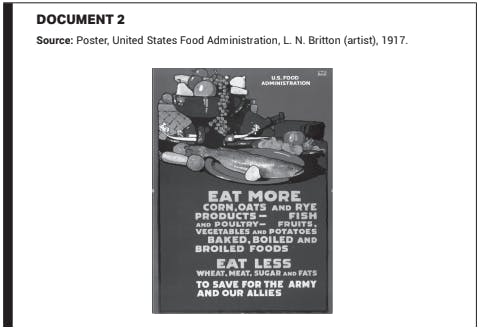
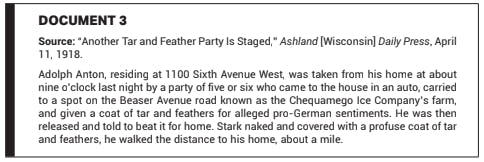
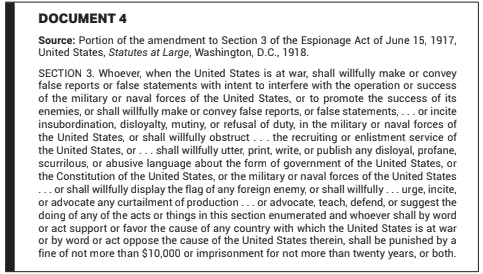
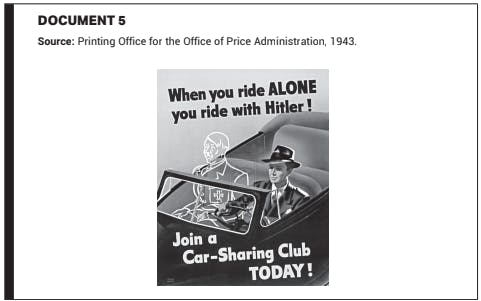
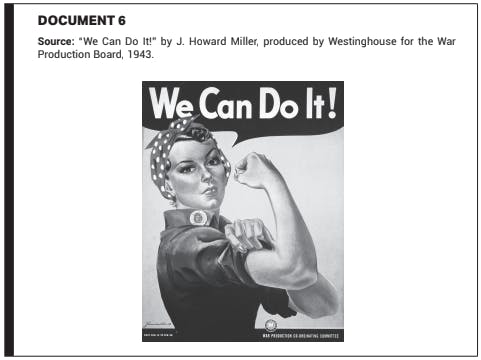
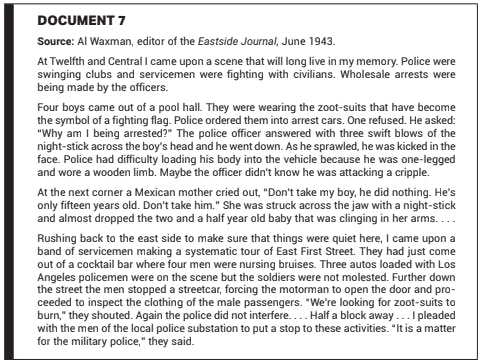
Check your answer.
This document-based question asks you to compare the mobilization efforts of World War I with those of World War II. As you look at the documents, several themes should emerge. One theme that quickly emerges is that in both World War I and World War II, the role of the federal government grew. We can see this in the conservation efforts in both wars. In World War I, we see this in Document 2, a poster from the Food Administration urging a change in diet to prevent shortages of certain commodities (meat, sugar, and fat) for the war effort. In World War II, we see a similar effort at conservation in Document 5; commuters are urged to carpool so as to save fuel for the war effort.
In addition to conservation, we can see that in both wars authorities put a good deal of effort into filling defense-industry plants with workers. For World War I, we see this implied in Document 1—the efforts of the War Industries Board. For World War II, we see this effort in Document 6, urging women to take industrial jobs, assuring them that they could handle such jobs. The World War II efforts to find employees are alluded to in Document 7 as well. This document describes one of the “zoot-suit riots” that occurred in Los Angeles and elsewhere during the war. These anti-Mexican riots occurred after the federal government instituted the Bracero program, allowing thousands of Mexicans to enter the United States legally as temporary guest workers.
Another theme that emerges in the comparison is the treatment of different ethnicities. In World War I, we see violence against German Americans in Document 3. This document should remind you of the rise in xenophobia and anti-German violence during World War I. In World War II, in addition to the violence against Mexicans in the “zoot-suit riots” (Document 7), we can go beyond the documents and cite discrimination against Japanese Americans with their forced relocation to the interior of the United States. In both wars, ugly expressions of ethnic hatred were unleashed by the war.
The final area of comparison to examine is the limits placed on civil liberties in both conflicts. In World War I, the government passed the Espionage and Sedition Acts, limiting free-speech rights. These acts are referenced in Document 4, an excerpt from the Espionage Act. During World War II, the government limited the civil liberties of the entire population of West Coast Japanese Americans by issuing Executive Order 9066, calling for the internment of people of Japanese descent in a series of camps. In both wars, the government expanded its power to limit civil liberties. You can judge the merits of each action, noting similarities and differences.
A successful essay would earn a point for developing a strong thesis that addresses the prompt—one that makes a claim in regard to comparisons between government mobilization efforts during World War I with those of World War II. The thesis should reflect a complex understanding of the topic, an understanding that would then be developed in the body of the essay (see below for a discussion of historical complexity). The second possible point in the essay would be for contextualization. You must put the government mobilization efforts into a wider context. For instance, this essay could note that the efforts to expand the role of government during wartime occurred in the context of broader efforts to expand the role of government in society. In the case of World War I, this would involve discussing the efforts of the Progressive movement; in the case of World War II, this would involve invoking the ideology of the New Deal. The next three points would be for using evidence—both within and outside of the documents. For the first of these points, the essay must successfully use the content of at least three of the documents to address the topic of the prompt. The next point can be earned for using the content of at least six of the documents in a way that supports an argument in response to the prompt. The third evidence point would be for using evidence outside the documents—the circumstances of the arrest of Eugene Victor Debs during World War I, the role of Herbert Hoover as administrator of the Food Administration during World War II, or the Bracero program during World War II. To earn this point, the essay must explain how the outside evidence is relevant to the argument. It is not enough to simply mention or describe this information.
The last two points are for analysis and reasoning. The first of these two points is for sourcing—for at least three of the documents, explaining how or why the document’s point of view, purpose, historical situation, and/or audience is relevant to the argument. For example, the essay could discuss the historical situation of Document 6—the “We Can Do It!” poster. Before the war, very few women worked in heavy industry. Women worked in lighter industry—notably the garment industry—but not in the shipbuilding industry. The poster played a role in changing this gender norm. This point could be connected to a broader argument about changing conceptions of gender during times of war. Or, the essay could discuss the purpose of the Espionage Act (Document 4) during World War I. This point could note that the act was designed to blunt objections to a war that was widely criticized by Americans. This could be connected with a broader point about the role of government in organizing and producing enthusiasm for American participation in military ventures. The last point is for demonstrating a complex understanding of the historical development that is the focus of the essay. This point could be earned by extending the argument to another time period—such as the Civil War or the Vietnam War—and drawing conclusions about the growth of federal power during times of crisis. Or, the argument could be modified by considering diverse or alternative views or evidence, such as how the impact of World War II mobilization on African Americans differed from the impact on white Americans. This point could focus on discrimination in war-related industries and the moves by A. Philip Randolph and other civil-rights leaders to organize a major civil-rights demonstration during the war. This point could also note that the demonstration was called off when President Franklin D. Roosevelt issued an executive order banning segregation in war-related industries.
How is the Document-Based Question Scored?
The document-based question on the APUSH exam is scored on the four elements described below. Understanding how the document-based question’s grading system can help you achieve a top score of 7.
- Thesis: 0-1 points
Earn 1 point by responding to the prompt with a historically defensible thesis/claim that establishes a line of reasoning. - Contextualization: 0-1 points
Earn 1 point by describing a broader historical context relevant to the prompt - Evidence: 0-3 points
Earn 1 point by using the content of at least three documents to address the prompt’s topic, or earn 2 points by supporting an argument in response to the prompt using at least six documents. Earn an extra point by using at least one additional piece of specific historical evidence beyond that found in the documents relevant to an argument about the prompt. - Analysis & Reasoning: 0-2 points
Earn 1 point by using at least three documents to explain how or why the documents’ point of view, purpose, historical situation, and/or audience is relevant to an argument. Earn a second point by demonstrating a complex understanding of the historical development that is the focus of the prompt, using evidence to corroborate, qualify, or modify an argument that addresses the question.
AP U.S. History Question Types: Long Essay Question
The last part of the AP U.S. History exam is the long essay question, or LEQ. In Section II, Part B, you will choose between three similar long essay questions. You will have 40 minutes to complete this part on the exam. 15% of your grade is based on your response to the LEQ.
The long essay requires you to develop a thoughtful historical thesis or argument and support your thesis with an analysis of specific and relevant historical evidence. Each of the three questions you’ll choose from will focus on the same historical reasoning process—comparison, causation, or continuity and change. The LEQ also assesses four historical thinking skills—developments and processes, contextualization, making connections, and argumentation. Where the three questions differ is in the time periods they cover. The first question will draw on material from Periods 1 through 3, the second from Periods 4 through 6, and the third from Periods 7 through 9. Be sure to pick the essay question you feel most prepared and confident to answer.
[ LISTEN: Barron’s AP U.S. History Podcast Episode 12: “The Long Essay” on Apple and Spotify ]
Sample Long Essay Prompt
Below are three sample long essay questions. The three questions are all built around the same
theme and the same historical reasoning skill. The theme for each question is “Culture and Society.” These questions ask you to analyze patterns of continuity and change regarding the roles and conditions for women during three different periods in American history.
Directions: Answer Question 1 or Question 2 or Question 3.
In your response, you should do the following:
- Respond to the prompt with a historically defensible thesis or claim that establishes a line of reasoning.
- Describe a broader historical context relevant to the prompt.
- Support an argument in response to the prompt using specific and relevant examples of evidence.
- Use historical reasoning (e.g., comparison, causation, continuity or change over time) to frame or structure an argument that addresses the prompt.
- Use evidence to corroborate, qualify, or modify an argument that addresses the prompt.
- Evaluate the extent to which roles and conditions for women changed in the United States in the period 1750 to 1800.
- Evaluate the extent to which roles and conditions for women changed in the United States in the period 1800 to 1850.
- Evaluate the extent to which roles and conditions for women changed in the United States in the period 1940 to 1980.
Check your answer to Question #1.
Question 1, on changes and continuities in regard to women’s roles and conditions, covers the time period of the crisis of empire, from the end of the French and Indian War through the ratification of the Declaration of Independence, the American Revolutionary War (1765–1783), and the development of an independent United States, up to 1800. In addition, Enlightenment thinking—much of which explicitly challenged traditional gender roles—became important in the Revolution and in the early republic. These political and intellectual developments could be used in this essay to establish the context of the essay.
A key change to note in terms of roles and conditions for women in this period is the increasingly public role women played in these major events. This was the era of the Daughters of Liberty, boycotts, spinning bees, and homespun cloth. In North Carolina in 1774, fifty-one women signed a declaration vowing to give up tea and other British products, in what is known as the Edenton Tea Party. Abigail Adams reflected Enlightenment ideals when she encouraged her husband, John, to “remember the ladies” as the structure of a new nation was being debated in 1776. Some women participated in the fighting of the American Revolution, including Deborah Sampson of Massachusetts, who dressed as a man and served in several theaters of war. Many women participated in supplying the soldiers and working as nurses. In the early republic, the ideas of republican motherhood developed. These are all pieces of evidence that could be used to support an argument in this essay.
As you develop an argument to respond to this prompt, think about the final point for demonstrating a complex understanding of the topic. For instance, if an essay discusses changes for women in this period, it might acknowledge continuities as well (explaining both continuity and change). By 1800 women still did not have the right to run for office or vote. Many of the legal strictures on married women, under the doctrine of feme covert, were in place. And though republican motherhood asserted that women had an important role to play in the new republic, it was still as mothers. Further, some of the changes that impacted white women had no impact on enslaved African-American women (qualifying or modifying an argument by considering diverse or alternative views or evidence).
A strong thesis to this question could attempt to acknowledge change, while stressing its limited nature. “During the period of 1750 to the 1800s, conflicts between the colonists and the British opened new avenues for women to participate in public life. By 1800, however, the laws and constitutions that were created in the new republic relegated women to second-class status just as they had been under British rule.” A different tack in developing a thesis might acknowledge different perspectives: “For many white women, the crisis of empire and the birth of a new country offered new opportunities and possibilities to participate in the public realm. However, for enslaved African-American women, the rhetoric of the American Revolution changed little.”
A successful essay would bring all the elements of the essay together—relevant contextualization, a strong thesis, evidence in support of the argument of the essay, and a complex understanding of the topic.
How is the Long Essay Question Scored?
The long essay question on the AP U.S. History exam is scored on a scale from 0 to 6, with 6 being the highest score you can receive. Below is a description of the specific scoring criteria for each element of the long essay.
- Thesis: 0-1 points
Earn 1 point by responding to the prompt with a historically defensible thesis/claim that establishes a line of reasoning. - Contextualization: 0-1 points
Earn 1 point by describing a broader historical context relevant to the prompt. - Evidence: 0-2 points
Earn 1 point by providing specific examples of evidence relevant to the prompt’s topic, or earn 2 points by supporting an argument in response to the prompt using specific and relevant examples of evidence. - Analysis & Reasoning: 0-2 points
Earn 1 point by using historical reasoning (comparison, causation, or continuity and change over time) to frame and structure an argument that addresses the prompt. Earn 2 points by demonstrating a complex understanding of the historical development that is the focus of the prompt, using evidence to corroborate, qualify, or modify an argument that addresses the question.
AP Biology Resources
- About the AP Biology Exam
- Top AP Biology Exam Strategies
- Top 5 Study Topics and Tips for the AP Biology Exam
- AP Biology Short Free-Response Questions
- AP Biology Long Free-Response Questions
AP Psychology Resources
- What’s Tested on the AP Psychology Exam?
- Top 5 Study Tips for the AP Psychology Exam
- AP Psychology Key Terms
- Top AP Psychology Exam Multiple-Choice Question Tips
- Top AP Psychology Exam Free Response Questions Tips
- AP Psychology Sample Free Response Question
AP English Language and Composition Resources
- What’s Tested on the AP English Language and Composition Exam?
- Top 5 Tips for the AP English Language and Composition Exam
- Top Reading Techniques for the AP English Language and Composition Exam
- How to Answer the AP English Language and Composition Essay Questions
- AP English Language and Composition Exam Sample Essay Questions
- AP English Language and Composition Exam Multiple-Choice Questions
